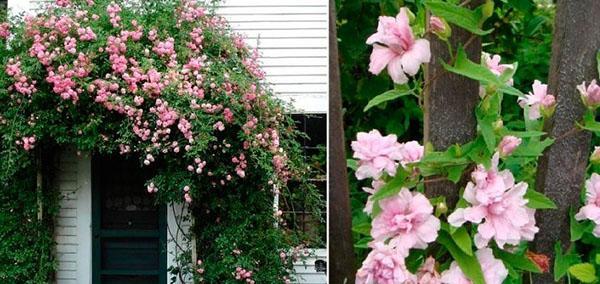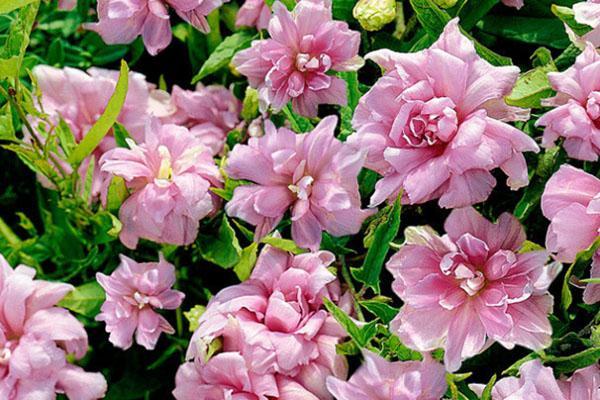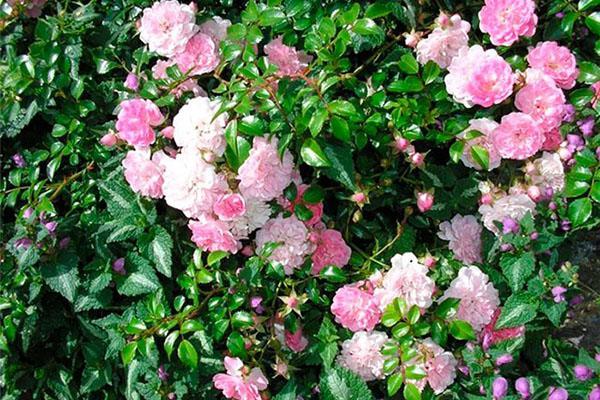French roses in vertical gardening: calistegia
 Gardeners are very fond of growing vines, and not only deciduous, but also flowering species, as they look spectacular. One of the most popular among them is calistegia. The advantage of these plants is obvious: they can become the main element of vertical gardening, which can hide from prying eyes any old building, not a very beautiful hedge, which can ruin the overall appearance of the garden. So, the calistegia, the photo of which you see below, may well become not only a favorite, but also an assistant to gardeners. An unpretentious plant will delight those around you with bright beauty throughout the warm season, some varieties bloom until the first frost.
Gardeners are very fond of growing vines, and not only deciduous, but also flowering species, as they look spectacular. One of the most popular among them is calistegia. The advantage of these plants is obvious: they can become the main element of vertical gardening, which can hide from prying eyes any old building, not a very beautiful hedge, which can ruin the overall appearance of the garden. So, the calistegia, the photo of which you see below, may well become not only a favorite, but also an assistant to gardeners. An unpretentious plant will delight those around you with bright beauty throughout the warm season, some varieties bloom until the first frost.
Calistegia terry cultivation (photo)

Perennial vines - bindweed are unpretentious, however, somewhat aggressive. These plants grow so abundantly that experts do not recommend planting them on flower beds next to other plants, while not limiting the unrestrained growth of their roots.
In order for the root system to not spread horizontally throughout the entire area and not strangle other inhabitants of the garden, it is imperative to dig in a sheet of slate or plastic around the vine to a depth of about forty centimeters.
Landing rules
Above you see a photo, it has a wonderful terry calistegia, planting and caring for which, in principle, is not difficult. This plant is propagated by dividing the creeping roots. At first, they are simply rooted in small greenhouses, and then they are planted in their permanent place. For landing you need:
- prepare a trench, which must be dug deep into the bayonet of a shovel;
- fill a hole mineral fertilizer;
- add ash and humus.
In the prepared trench, pre-rooted future plants need to be laid out to a depth of about twenty centimeters at a distance of 25 - 30 cm from each other. It is also possible to root the plant by planting small stems, but it will have to be covered in the first winter (with dry leaves or spruce branches). Such a vine can grow in the same place for about ten years or even more, while your bindweed will bloom profusely every year. So you should think about the nutrition of this plant in advance.
Care
 So, the cultivation of terry calistegia (photo above) does not imply difficult care, but almost immediately after planting it you need to equip supports, at least just pull a small wire or put up posts. It is necessary that the support should not be more than ten centimeters in diameter, otherwise the vine will not be able to wrap its branches around it.
So, the cultivation of terry calistegia (photo above) does not imply difficult care, but almost immediately after planting it you need to equip supports, at least just pull a small wire or put up posts. It is necessary that the support should not be more than ten centimeters in diameter, otherwise the vine will not be able to wrap its branches around it.
Young seedlings should be watered abundantly, however, waterlogging of the soil is categorically unacceptable.
In the middle of summer, the bindweed will grow up to one and a half meters, the first buds will begin to form. In order to maintain this flowering, the plant should be fed. Once a couple of weeks, ordinary mineral fertilizer should be applied, according to the norms specified in the annotations and instructions.
If the summer is very cold, then the calistegia should be treated with caution with fungicides. By the way, snails are very fond of this plant, they damage the buds that have tied up and gnaw through hefty holes on the leaves. If this happens, biological (or chemical) methods of pest control must be applied.
Withered flowers should be constantly removed, otherwise the vine will not look neat. This must be done all summer before the end of flowering.
In autumn, all the ground parts of the plant die, so it makes sense to simply cut the vine after the first frost in the fall, when the plant loses its decorative effect. For all types of these vines, including, for example, a multiplex calistegia, planting and care is basically the same. An adult plant does not need to be covered for the winter, unless the region is extremely cold. In late spring, your vine will wake up. In the middle zone, this happens at the very end of May, when frosts, as a rule, do not happen anymore. If they are still expected, then the young stems should make a small shelter.
Some types of Calistegi
There are about twenty or more varieties of Calistegia, but only a few species are grown in gardens, others are wild and even considered harmful weeds.
Calistegia is fluffy.
 This plant came to us from China, it has the longest branches, its shoots are very long, can reach up to four meters. The stems of the plant are covered with bright, green, elongated leaves that have a leathery surface. Fluffy calistegia happens with both simple and terry flowers, their diameter can reach up to 9 centimeters, but there are also small flowers of 3-4 centimeters. The petals are usually colored in a delicate pink shade with a darkish base.
This plant came to us from China, it has the longest branches, its shoots are very long, can reach up to four meters. The stems of the plant are covered with bright, green, elongated leaves that have a leathery surface. Fluffy calistegia happens with both simple and terry flowers, their diameter can reach up to 9 centimeters, but there are also small flowers of 3-4 centimeters. The petals are usually colored in a delicate pink shade with a darkish base.
Ivy calistegia
 The plant is very unpretentious, it grows instantly, and blooms from the beginning of summer until the first frost, and very abundantly. The branches grow up to two to three meters, small bright leaves and double pale pink large flowers (diameter 9 centimeters) appear on them. The most favorite among flower growers has become the calistegia ivy flora Pléno. It was her huge double flowers that were nicknamed the French rose for their obvious resemblance to a prickly and unapproachable beauty. Amazingly beautiful buds with a delicate aroma cover the entire length of the vine.
The plant is very unpretentious, it grows instantly, and blooms from the beginning of summer until the first frost, and very abundantly. The branches grow up to two to three meters, small bright leaves and double pale pink large flowers (diameter 9 centimeters) appear on them. The most favorite among flower growers has become the calistegia ivy flora Pléno. It was her huge double flowers that were nicknamed the French rose for their obvious resemblance to a prickly and unapproachable beauty. Amazingly beautiful buds with a delicate aroma cover the entire length of the vine.
Intake calistegia
 They called this species for a reason, this calistegia, photo above, just near the fence. If this plant were not so aggressive, it could also be one of the types of decorative vines. This variety grows in all regions of our country, it is considered a weed. Long, slender shoots are usually covered with small leaves and simple white or pale pink bells.
They called this species for a reason, this calistegia, photo above, just near the fence. If this plant were not so aggressive, it could also be one of the types of decorative vines. This variety grows in all regions of our country, it is considered a weed. Long, slender shoots are usually covered with small leaves and simple white or pale pink bells.
Calistegia multiplex
This type of vine grows up to three or even more meters in length. On the branches, dark triangular leaves are located quite close to each other. The flowers of this species are very large, bright and double. Each of the flowers of the multiplex calistegia may well reach ten centimeters in diameter, most importantly, do not forget to feed it during flowering.
Calistegia and vertical gardening
 This vine is made for vertical landscaping projects. Of course, your garden has gazebos, small arches where the bindweed will feel great. An ordinary chain-link can be an excellent basis for a beautiful hedge. You can see any calistegy in the photo just near some kind of support. So, the purpose of this plant is to twist and braid. Without support, the kalistegia grows unimportantly, it may refuse to bloom, therefore the main concern of the gardener is to provide this vine with a decent support:
This vine is made for vertical landscaping projects. Of course, your garden has gazebos, small arches where the bindweed will feel great. An ordinary chain-link can be an excellent basis for a beautiful hedge. You can see any calistegy in the photo just near some kind of support. So, the purpose of this plant is to twist and braid. Without support, the kalistegia grows unimportantly, it may refuse to bloom, therefore the main concern of the gardener is to provide this vine with a decent support:
- The pillars, not thick columns and poles, the kalistegia wraps around perfectly. If the pillar is too large in diameter, you need to stretch the wire around the creeper.Terry kalistegia can hide any unsightly garden supports.
- You can decorate the facade of your house with a liana calistegi around the perimeter. It is necessary to gird the contour around the door with a narrow strip of mesh. Liana will perfectly emphasize the architecture of classical columns. For an English-style home, this option is ideal.
- Such a liana looks great, like the calistegia of the flora of captivity in the arch. The perimeter of this arch can be made in the form of a narrow mesh strip. At the same time, Kalistegia is planted in two places, at the base of the arch, and the branches are directed towards each other.
Since calistegia, even terry, does not form panoramas and dense mosaics in the garden, it can be combined with some other beautiful vines. It could be, say, clematis.
 Kalistegiya liana is quite suitable for a pre-planned solemn event. For example, if a wedding is celebrated in the house in a few months, you can manage to plant two or three rhizomes in the intended place, and soon the lush pink buds will delight the eyes of the guests. So, calistegia, despite its aggressive disposition, can become one of the most beloved plants in your garden.
Kalistegiya liana is quite suitable for a pre-planned solemn event. For example, if a wedding is celebrated in the house in a few months, you can manage to plant two or three rhizomes in the intended place, and soon the lush pink buds will delight the eyes of the guests. So, calistegia, despite its aggressive disposition, can become one of the most beloved plants in your garden.